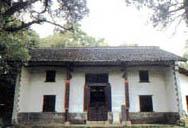1) West Hunan


湘西
1.
Adaptability of the Import Potato Varieties in West Hunan;


几个马铃薯引进品种在湘西栽培的适应性研究
2.
Ornamented Tubes from Middle Cambrian of Huayuan, West Hunan, China;


湘西花垣中寒武统具表面装饰的管状微体化石
3.
Reasonably Developing and Utilizing Mineral Resources to Serve the Building up of Economy of West Hunan;
合理开发利用矿产资源 为湘西经济建设服务
2) western Hunan


湘西
1.
Study on Wild Nectar and Pollen Plant Resources in Western Hunan;


湘西野生蜜粉源植物资源的研究
2.
Discovery of fold structure in Xi an W-Au deposit of Taoyuan County,western Hunan,and its ore-controlling significance;
湘西桃源县西安钨金矿床褶皱构造的发现及控矿意义
3.
Investigations on Resources of Common Wild Edible Plants Utilized by National Minorities in Western Hunan;
湘西州少数民族膳食结构中常见野生植物调查研究
3) Xiangxi


湘西
1.
On Geological Characteristics of Xiangxi Manganese Ore Deposit Indicator and Direction;


湘西锰矿成矿地质特征及找矿方向探索
2.
Tourism Resources Development:SWOT Analysis and Research Model——A Case Study of Xiangxi Autonomous County of Hunan Province;
我国旅游资源开发SWOT分析及模式探讨——以湖南省湘西自治州为例
4) The West of Hunan


湘西
1.
He applied the quintessence of the ghost culture into his works tactfully,expanded art space skillfully,and constructed the world in the west of Hunan which is full of the smell of primitive life with elaborate attention.
他巧妙运用湘西巫鬼文化的精髓,拓展艺术空间,精心构筑出具有原始生命气息的"湘西世界",在城市与乡村的边缘人生中孤独徘徊,笑颜千古
2.
During the periods of Ming and Qing,the folk custom culture of Bai nationality in the west of Hunan has deeply changed in producing,daily life,religious belief,language and literature and art.
明清时期,湘西白族民俗文化在生产、生活、宗教信仰、语言及文学艺术等方面发生了深刻变迁,呈现出念本性、磨合性、融合性、和谐性等系列动态特征。
5) western part of Hunan


湘西
1.
By using the data obtained from investigation on physical condition of minority students in western part of Hunan and Qing-Tibet plateau during 1985~2000,this paper makes dynamic analysis,comparison and observation on physical condition.
为了提高湘西、青藏高原少数民族学生体质健康水平 ,利用湘西、青藏高原 2 0 0 0年和1985年少数民族学生体质健康调研所获得的数据 ,对湘西、青藏高原少数民族学生的体质状况作 15年的动态观察、对比和分析。
2.
Using the data obtained from investigation of constit ut ion and health state of Tujia students from1985-2000 in western part of Hunan pr o vince,this essay analyses the difference of constitution of Tujia students after 15 years observation and comparison in order to provide scientific foundation f or the improvement of the constitution and health level of the minority students .
利用湘西 1 985年和 2 0 0 0年学生体质健康调研所获得的数据 ,对湘西土家族学生的体质状况作 1 5年的动态观察、对比和分析。
3.
Using the data obtained from investigation of pupils physical fitness and health during 1985-2000 in western part of Hunan province, and analyses the difference of constitution of Tujia and Miao minorities after 15 years observation, comparison and analysis in order to provide scientific basis for improving minority nationality pupils physical fitness and health.
利用湘西1985年和2000年学生体质健康调研所获得的数据,对湘西地区土家族、苗族学生的体质状况作15年的动态观察、对比和分析。
6) northwest Hunan


湘西北
1.
A tentative discussion on genesis of lead-zinc deposits in northwest Hunan;


湘西北铅锌矿床碳氢氧同位素特征及成矿环境分析
2.
Study on regional economy sustainable development of Northwest Hunan;


湘西北区域经济可持续发展问题研究
3.
This paper uses the Ni-Mo ore beds in northwest Hunan as example to discuss how to comprehensively use the Ni-Mo resource, especially Au, Pt, Pd precious metals and P non-metal resource.
矿物资源的综合利用具有极其重要的意义 ,以湘西北黑色岩系中的镍、钼多矿种矿层为例 ,探讨了如何合理综合利用本地镍、钼金属资源 ,尤其是金、铂、钯等贵金属矿产以及磷等非金属资源 ,并结合经济、环境等多方面因素的考虑自行设计了利用流程 ,指出了湘西北多矿种资源综合利用的广阔前景 ,同时提出了可行性建
补充资料:湘西草堂

湘西草堂
座落于衡阳县曲兰乡湘西村菜塘弯,是我国明末清初著名思想家、哲学家王船山的故居。始建于清康熙十四年(1675年),有茅屋三间,左为住房,右为书房。王船山先生后半生在此潜修十七年,遗著800余万字。
1981 年省文化局拨款重修草堂,定为省重点文物保护单位。现草堂占地2100平方米,建筑面积180平方米。正厅面首横挂赵朴初先生书写的《湘西草堂》匾额,厅堂内正面墙上挂着船山画像,像下分别挂放“岳衡仰止》等称道船山先生的横幅金匾,厅堂内两侧墙上挂着清代著名人物题写的楹联。正厅的左边正房为住室,陈列有船山的床铺、被席、书桌、七弦琴等复制品;右边的正房是书房,陈列有船山的部分著作,还有当代全国著名书画家撰写的条屏、楹联。
草堂院内,茂林修竹,绿荫如盖,旁有古枫,其干粗大而弯曲,形若骏马昂首跃前,王船山生前称之为“枫马”。还有一株古藤,铁骨盘旋,蜿蜒上升,俗称“藤龙”。据说是王船山亲手栽的。如今枫马藤龙奇状异貌,生机盎然,中外游客誉之为草堂“奇观”。
离湘西草堂4公里的曲兰乡船山村大罗山脉的虎形山上,有座船山墓庐,系清光绪三十四年(1908)年衡永郴桂巡道谭启瑞修建。1981年又按原貌进行了修建。坟圈青石砌就,正中立汉白玉石碑,上刻“伟大思想家王而农先生之墓”。旁刻有自题墓志铭:“抱刘越石之孤愤而命无从致,希张横渠之正学而力不能企。幸全归于兹邱,故衔恤以永世。”坟圈刊清代名人王闿运及唐鉴词。坟墓主体占地100平方米,正中为王夫之墓,左为王夫之之继配夫人墓,右为王夫之四儿媳刘氏坟,坟盘共石阶三级。二级石阶分别立《重修墓记》和《保护告示》。两边石刻对联两幅:“前朝干净土;高节大罗山。世臣乔木千年屋;南国儒林第一人。”
说明:补充资料仅用于学习参考,请勿用于其它任何用途。